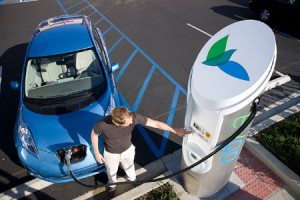The City Is The Crucible For The Electric Vehicle Market
 After little more than a year on the roads, the first mass-market electric vehicles have attracted tremendous scrutiny. On a monthly basis, commentators and automotive journalists proclaim their success or failure, based on sales fluctuations. At first glance, the equation seems simple: automobile companies build cars, and if they’re popular enough, they’ll sell.
After little more than a year on the roads, the first mass-market electric vehicles have attracted tremendous scrutiny. On a monthly basis, commentators and automotive journalists proclaim their success or failure, based on sales fluctuations. At first glance, the equation seems simple: automobile companies build cars, and if they’re popular enough, they’ll sell.But the EV market is arguably more complex than the traditional vehicle market. Sales result not only from automaker marketing but from a groundswell of support. Amounting to somewhat of a global movement, the EV market consists of an array of stakeholders—automakers, technology companies, governmental agencies, nonprofits, manufacturers, fleet owners, and consumers—all bringing unique motivations and perspectives on vehicle electrification. But they coalesce in one place—the city.
The challenges of transitioning to vehicle electrification are real. The internal combustion engine has been the established automotive technology for over a century. Switching out this familiar technology with the electric powertrain will not happen overnight. And it may not happen with any real scale without a concerted effort to support the industry. So stakeholders across the EV value chain are coming together in cities around the world, creating test beds and strongholds for the market. By fostering coordination among these entities, cities can create a localized movement and an adoptable model for others to follow. Replicating those efforts helps boost the electric vehicle industry’s chances for success.
EV-Ready Cities
Many cities have a clear incentive to support electric vehicles. For instance, in Los Angeles, passenger cars make up nearly 80 percent of daily travel, which in turn accounts for 43 percent of the city’s carbon emissions. A wide-scale transition to electric vehicles for daily travel would have positive impacts on Los Angeles’s dependence on oil, as well as its air quality. Particularly given that the city’s electricity mix consists of a high share of renewables, the technology poses a clear improvement over gasoline-powered vehicles.
In order to capture these benefits, the city is engaging multiple stakeholders to encourage adoption. At the Los Angeles International Airport (LAX) and the Port of Los Angeles, fleet owners are purchasing electrified buses and utility vehicles. In the case of LAX, an electric bus will greatly offset fuel consumption and result in savings of up to $500,000. In order to understand and encourage public demand, the mayor’s office has formed a collaborative research project with C40 Cities Climate Leadership Group (C40), UCLA’s Luskin Center, and the Los Angeles Department of Water and Power.
In Germany, Berlin established a goal to become the leading metropolis for electric mobility in Europe. The city launched eMO, short for electromobility, to serve as a central contact point for the entire value chain of electric vehicle projects and stakeholders. The group has designated demonstration sites where the public can experience and test the vehicles. In addition, Berlin’s E-City logistics project has is demonstrating the potential for electrified commercial delivery vehicles. Because of their reduced noise level, deliveries can be shifted to off-peak hours and nights, cutting down on traffic.
These kinds of projects result in several benefits for a city. For one, they position a city as a leading supporter of a burgeoning industry. Mayors and community leaders around the world are eager to develop this kind of recognition because it not only improves the city’s image, it also attracts industry and fosters job growth. Automakers will increase marketing of these vehicles in centers of concentrated demand. Likewise, manufacturers and others in the value chain tend to locate operations in areas of considerable public and private support.
Several organizations are leveraging the efforts of these cities through national and global networks. The Clean Energy Ministerial, a high-level multi-government forum that promotes policies and programs to advance clean energy technologies, established the Electric Vehicles Initiative to accelerate EV deployment in cities across the world. With representation from DOE and the International Energy Agency, EVI has a global reach, backed with solid research.
Similarly, Rocky Mountain Institute’s Project Get Ready works with North American cities to advance vehicle electrification readiness projects and establish best practices for infrastructure deployment and utility integration. C40, which is partnered with the Clinton Climate Initiative, established a large network of cities around the world, with the goal of reducing carbon emissions and improving energy efficiency. Their work has resulted in several EV pilot projects.
The electric vehicle industry shows no signs of quitting. Nearly every major automaker will offer at least one electric vehicle model to its customers within the next two years. The automakers’ commitments are real. However, the level of success is unknown. What is understood, though, is that city leaders can play a significant role in supporting this technology by attracting and coordinating with industry stakeholders.
As part of a new global information-sharing partnership, RMI on May 5 will release a collection of case studies on pioneering cities and public-private partnerships, at the EV Cities and Ecosystems conference in Los Angeles. Visit rmi.org or follow us on Twitter (@RockyMtnInst) for updates and live blogging from the event.
You can return to the main Market News page, or press the Back button on your browser.

